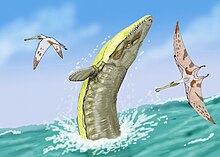Metriorhynchidae
| Metriorhynchidae | ||||||||||||
|---|---|---|---|---|---|---|---|---|---|---|---|---|

|
||||||||||||
| Temporal occurrence | ||||||||||||
| Middle Jurassic ( Callovium ) to Lower Cretaceous ( Aptium ) | ||||||||||||
| 166.1 to 112.9 million years | ||||||||||||
| Locations | ||||||||||||
|
||||||||||||
| Systematics | ||||||||||||
|
||||||||||||
| Scientific name | ||||||||||||
| Metriorhynchidae | ||||||||||||
| Fitzinger , 1843 | ||||||||||||
The Metriorhynchidae are a group of extinct marine crocodile relatives that lived from the Middle Jurassic to the Lower Cretaceous . Their fossil remains were found in Europe as well as in North and South America. They were the archosaurs most adapted to aquatic life .
features
All of the Metriorhynchidae were highly adapted to marine life. You have one or two cervical vertebrae today less than the crocodiles, the number of presacral vortex (eddy in front of the pool ) is 26 but higher. The vertebrae are concave (amphicoel) at both ends , a characteristic of all primeval crocodile-like species. At the end of the tail, the spine bends downwards and, similar to the ichthyosaurs , supports a hypocerkic caudal fin. Impressions of the caudal fin have been preserved in some specimens found in Germany. The Metriorhynchidae have lost the bone armor under the skin that is common in all other crocodiles and crocodile-like species . Their limbs are transformed into fins. The upper temporal opening , which the Metriorhynchidae like all Diapsids have, is greatly enlarged in them compared to semi- aquatic and terrestrial crocodile-like species. The cause can be particularly long jaw muscles, which allow a very wide opening of the mouth. The largest species, Dakosaurus andiniensis , reached a length of six meters, other large species reached lengths of four to five meters.
Way of life
The fact that the fossil-bearing rocks , according to their facies , were deposited far from the coast in the open sea suggests that the Metriorhynchidae were ocean dwellers . They must have been quick hunters who fed on fish and cephalopods . The Dakosaurus andiniensis , found in Patagonia in 1996 , had a massive skull and probably ate other marine reptiles and large marine animals. It is unknown how the Metriorhynchidae reproduced. Like today's sea turtles, they may have crawled ashore and laid eggs, or like some of today's sea snakes and ichthyosaurs, they may have been viviparous .
Systematics
The closest relatives of the Metriorhynchidae are the Teleosauridae , with which they share the double concave vertebrae, the structure of the skull and the structure of the secondary palate . With them and the genus Pelagosaurus , the Metriorhynchoidea form the taxon of Thalattosuchia .
Genera
- Subfamily: Metriorhynchinae
Fitzinger , 1843
- Metriorhynchus von Meyer , 1830
- Gracilineustes Young et al., 2010
- Rhacheosaurus by Meyer , 1831
- Maledictosuchus Parrilla-Bel et al., 2013
- Cricosaurus Wagner , 1858 (synonym Enaliosuchus Koken , 1883 )
- Subfamily: Geosaurinae Lydekker , 1889
- Suchodus Lydekker , 1890
- Purranisaurus Rusconi , 1948
- Neptunidraco Cau & Fanti , 2011
- Tyrannoneustes Young et al., 2010
- Plesiosuchus Owen , 1884
- Torvoneustes Andrade et al., 2010
- Geosaurus Cuvier , 1824
- Dakosaurus Quenstedt , 1856
- Aggiosaurus Ambayrac , 1913
Teleidosaurus Eudes-Deslongchamps , 1869 (stands outside of the Metriorhynchidae)
literature
- Michael J. Benton : Paleontology of the vertebrates. Translation of the 3rd English edition by Hans-Ulrich Pfretzschner. Pfeil, Munich 2007, ISBN 978-3-89937-072-0 .
- Robert L. Carroll : Paleontology and Evolution of the Vertebrates. Thieme, Stuttgart et al. 1993, ISBN 3-13-774401-6 .
- Eric Buffetaut : The evolution of the Crocodilians. In: Scientific American . Vol. 241, No. 4, 1979, pp. 124-132.
Web links
- Mikko's Phylogeny Archive Metriorhynchidae
- The Paleobiology Database Classification of the Metriorhynchidae
